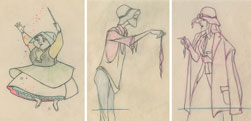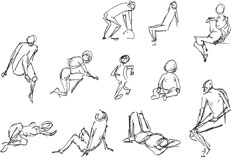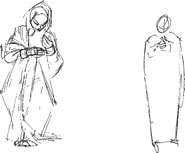137 A Simple Approach to Drawing
For those in my class who have had little instruction or experience, I would suggest adopting a very simple approach to drawing. Even those who are experienced but have neglected working from a model can benefit from this. In animation, costumes may run from simple to complex in style, but they are all handled in a simple manner when it comes to folds and wrinkles. There is a kind of shorthand for drapery that is standardized for all characters. Most Disney characters only have wrinkles at the joints, and then only when there is pressure applied by bending or squeezing. So they’ll occur at elbows and knees, and at the waist when seated. Women’s clothes have wrinkles caused by pleats, gathers, puffed sleeves, etc., but you can always count them on two or three fingers. An excess of material will cause meaningless folds, bumps, and bulges.

I have no control over what a model wears. I always ask them to wear something simple but often they come in some gaudy outfit with pleats, bulges, enormous jeweled belts, and abstract patterns and colors. All I can suggest is that it’s not our job to copy all that stuff, but to cut through the confusion and come up with a simple drawing — one that might duplicate the style used in a feature cartoon. This class after all is not for drawing bulges in cloth, but how to be able to construct a figure with clothes on in multitudes of gestures. The most logical approach when faced with a model that is clothed in a complicated costume is to lay in the basic pose with some simple elemental shapes. First study the pose for the gesture — you may have to add a little of your own thespianism — then look for weight distribution and overall abstract shape (silhouette), ignoring all particulars like muscles or other detail, and go for the general, overall generic gesture. This gives you the opportunity also to concentrate on relative proportions. Proportions are important and you must develop a sensitivity to them — Mickey, Roger Rabbit, the Mermaid, Eric, Sebastian — all with distinct proportions.
Here are some suggestions for a simple approach. You’ll not be encumbered or confused by a multitude of superfluous lines and puzzling shapes. Once you have the pose captured, the costume will be easier to put on. And using the known facts about wrinkles, you will be able to pick and choose the appropriate wrinkles from the model or make up some of your own. Let me suggest that in working out your “shorthand” body shape when the chest and hip are twisted, they can be handled as separate shapes. That way you can more easily draw them facing in different directions. When they are not twisting, the chest and hip areas can be treated as one shape.

Here’s a suggestion from Lariar’s book, Cartooning for Everyone, on how to lay in a cartoon figure. He had no explanation for this illustration but you can see, he worked from the general to the specific.

And here’s one example from our last drawing session where the artist got trapped into trying to feature the complications of the costume. Actually it was a very austere pose. There was a lot of cloth but it was wrapped tightly around the model’s body, making a simple but dramatic shape.

